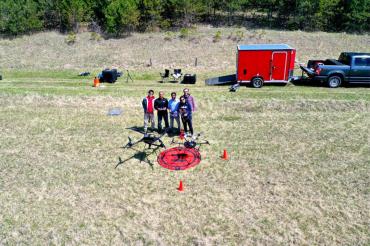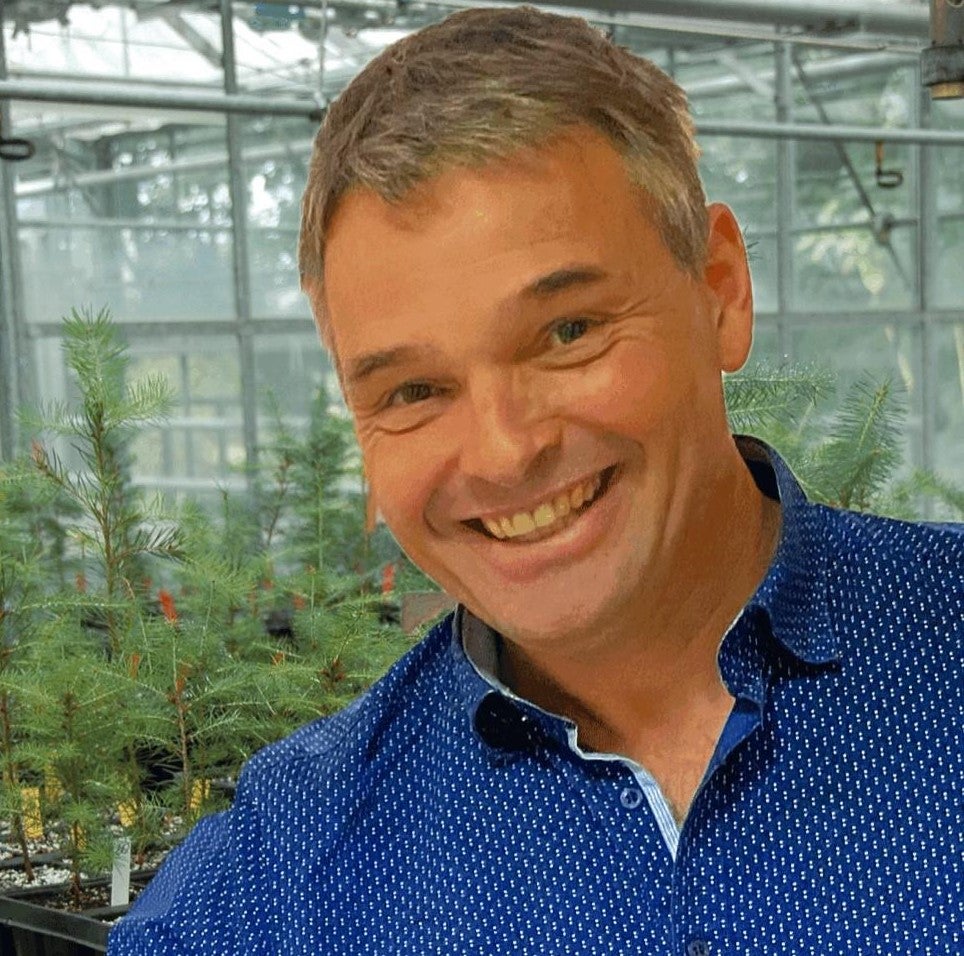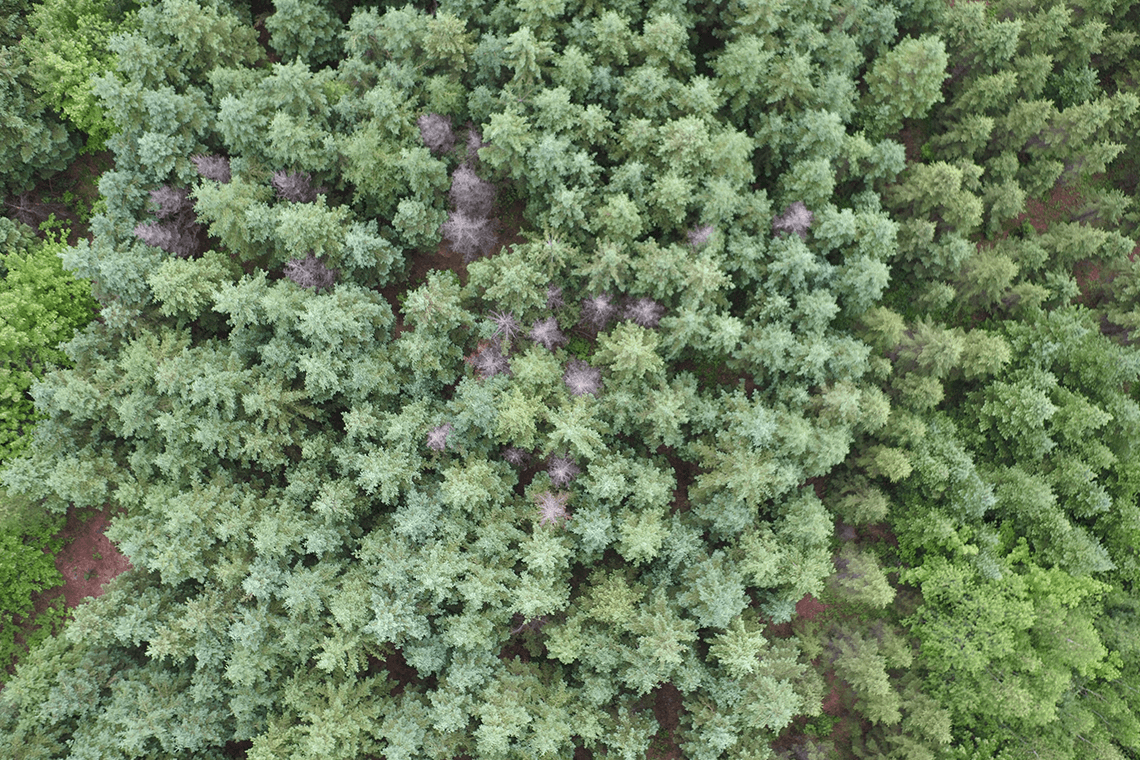Drone-based technology remotely assesses health of trees impacted by climate change

Published: May 24, 2022
Canada has nearly 362 million hectares of forest, but climate change is negatively impacting tree health and productivity. Trees planted today need to withstand future climate instability.
Enter Ingo Ensminger, an associate professor of biology at the University of Toronto Mississauga, and an innovative new technology that could provide further insights into tree health. Ensminger’s lab studies plant-environment interactions and the impact of climate change on metabolism and photosynthesis of plants from molecular to leaf, species and ecosystem level.
 Ingo Ensminger
Ingo EnsmingerEnsminger and his team have developed a drone-based technology, dubbed the FastPheno project, that remotely assesses photosynthetic phenology and plant fitness.
“Most people who use drones in trees and forests try to measure height and the size of the canopy, they use drones for inventories,” he says. “Our goal is different – we try to assess health and fitness, and overall performance as indicated by the ability of vegetation to remove CO2 from the atmosphere when they photosynthesize and produce biomass.”
Ensminger was recently awarded $4.7 million in funding for his FastPheno project by Genome Canada, an independent, federally funded not-for-profit.
“It is very rewarding to receive funding to develop and implement tools that will hopefully be used to help tree breeders and forest practitioners to identify trees that are resilient to climate change,” says Ensminger, who anticipates the tools will be used for tree improvement programs or to set targets for forest conservation and management.
Genome Canada’s Genomic Applications Partnership Program brings new applied genomics solutions to issues facing Canadians, and supports collaborations in forestry and other sectors.
The unique technology enables them to distinguish the performance of thousands of trees, and researchers can use the approach to detect drought stress control on photosynthesis in natural forests.
“All this is based on the optical fingerprint of vegetation,” Ensminger explains. “This fingerprint is derived by measurements of leaf spectral reflectance. Leaf spectral reflectance is highly variable, and it can be used as a plant health indicator, because it changes upon exposure to drought stress or heat stress.” The fingerprint is also species-specific, and hence future work in Ensminger’s lab will also explore how species can be distinguished to monitor biodiversity.
When it comes to tree breeding and forest conservation, the ability to distinguish trees that perform well during drought and heat is incredibly useful — complementing genomic selection with adaptive traits could help produce trees resilient to future climate in Canada.
Simply put, Ensminger believes, it could transform Canada's forest sector.
“Outcomes have been very promising,” Ensminger reports. “We can distinguish trees that are water-stressed from well-watered trees, we can assess how photosynthetic activity varies over the course of the year, and in large forest stands we can identify trees that perform well and distinguish those from unhealthy trees or trees that are stressed.”
Ensminger’s technology is fast, reliable and cost-effective compared to vegetation monitoring that relies on visual inspections and manual measurements. New research enabled through FastPheno now aims to apply the drone-based phenotyping approach at a large scale and explore how reliably it can be used across forests in Ontario and Quebec to monitor the health and fitness of individual trees.
If successful, FastPheno could create cost savings of $540 million per year and reduce assessment times from a matter of weeks to hours – and it can be transferred from forest vegetation to applications in agriculture, conservation and biodiversity studies.

St. Casimir experimental forest in Quebec, a field site where Ensminger and his team do a lot of their drone work (photo courtesy of Éric Dussault, Natural Resources Canada)
What’s next for Ensminger’s team? During their drone flights, they’re collecting an enormous amount of data – and now it’s a matter of processing and analyzing it. They’re collaborating with robotics experts to improve field data collection and will be developing tools to automate the process of image analysis and pixel classification using machine learning and AI technologies.
“We also aim to develop software and web-interfaces that provide users access so that not just researchers, but a wide range of end-users have access to the data produced through this approach,” he says.
“This is an exhilarating time for genomics,” noted Rob Annan, Genome Canada President and CEO, following a federal announcement of funding in March for FastPheno and other projects. “The knowledge, tools and technologies it is generating are driving innovation in traditional sectors and helping them achieve green growth, as well as improving the health and quality of life of Canadians.”
Ensminger’s project will complement the genomic selection research and operational programs of Natural Resources Canada and the Ministry of Forests, Wildlife and Parks of Quebec.



